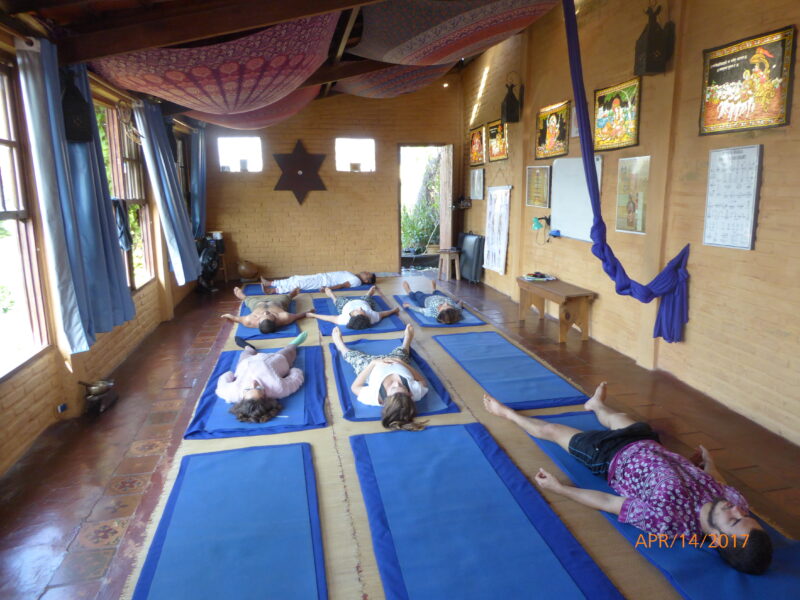Yoga Nidra
Table of Contents
What is Yoga Nidra?
Yoga Nidra is a Sanskrit word that means ‘yogic sleep.’ In yogic practices, it is counted as an effortless superconscious sleep. Yogic sleep is the art of reaching up to the highest level of self-awareness.
Yogic Nidra is highly suitable for all yoga practitioners and significantly changes daily life. It differs from regular sleep in which a practitioner is awake and aware of his inner self.

What happens during Yoga Nidra?
Yog Nidra is a form of guided meditation practice to visualize the most profound state of meditation. It starts from the conscious state to the superconsciousness level. During yog nidra, there are different experiences according to the person.
It is a different experience for yoga beginners in another state of mind. Yog Nidra brings a lot of wisdom and a sense of revealing the ultimate truth.
Where does Yoga Nidra come from?
India is the origin of yoga practices, and the six philosophies of Hinduism are the primary source of Yog Nidra. Patanjali formulated this practice in simple code. Sankhya’s philosophy has a great description of Yog Nidra.

Yoga sleep was a leading practice of the Indian subcontinent to be physically, mentally, and spiritually strong. Vedanta philosophy and Kashmir Shaivism also have texts on yog nidra.
How to practice Yoga Nidra?
Yog Nidra is one of the most accessible practices of yoga fundamentals. A certified yoga teacher does this practice. Yoga Nidra takes about 30 minutes to 45 minutes, and it is practiced in this formation: –
- Practice Nadi Shodan pranayama for 5 minutes to calm the nerves.
- Lie down in corpse pose or savasana and take a rest.
- Please align your physical body and stay at ease.
- Start to focus on prana and relax the mind.
- Sohum breathing is very effective in yoga nidra. When you inhale, feel the vibrations of So (I am), and during exhalation, practice Hum (that).
- As your mind will be steady and the frequencies will be at low intensity, you will be capable of attaining the state of consciousness.
- There is a big challenge to be consistent during practice. Now, deep silence will be required to go further.
- You may feel the sensation of internal body parts and the organs by which the concentration will be improved.
- Now, you may start feeling the colors of chakras and their presence.
- Overall, there will be a state when your mind will be entirely focused, and you may easily take off your senses from other matters.
Benefits of Yoga Nidra
Yog Nidra has a deep work on an individual. In regular practice, a person can quickly identify many experiences and improve his capabilities. The main benefits of yoga sleep are as follows:
- It is very effective after practicing yoga asanas to rest the body’s nervous system.
- Yog Nidra brings clarity to thoughts, and it gives a clear vision.
- It is highly suitable for attaining the most profound state of meditation.
- It improves the concentration level.
- People suffering from migraines and high BP should practice yoga nidra daily.
- It activates the brain cells, which is for sharpening the memory.
- Someone who is suffering from insomnia may practice it before bed.
- Yogic sleep activates all the chakras. It is a suitable medium for cleansing the chakra system of the body.
- To attain samadhi, yoga nidra is one of the best mediums. It prepares the physical body to stay longer in one position.
- To reach the level of super consciousness, yog nidra plays a vital role.
- Yoga Nidra brings joy, happiness, and compassion to the heart.
Precautions for practicing Yoga Nidra
Even though Yog Nidra has tremendous work on the human body, it has a few limitations. If someone is passing through these phases, he should follow some precautions, and these are:
- One should never practice yog nidra just after meals. The meal should be light and satvic before practicing it.
- It should not be practiced under the influence of alcohol or any other harmful activities.
- Someone who is practicing yog nidra should mind an open and clean space.
- It should never be practiced under any negative influence because it positively reacts to our personality.
- Practicing it in a silent zone where noise does not interrupt during the practice is highly advisable.
- Practicing it after covering the body parts properly is also very important.
- Yoga sleep should be avoided if a person is having a lot of anger.
- It should always be practiced under an experienced yoga teacher or guru.
Tags:


